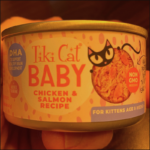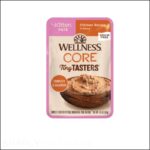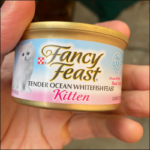Disclaimer: As a Chewy and Amazon affiliate, I earn from qualifying purchases. This does not impact our comparisons.
We’ve tested and reviewed over 50 cat food products over the past year to find what’s best.
Tiki Cat Baby comes out on top as the best overall choice to meet the nutritional needs of growing kittens.
It’s chock full shredded human quality meat for picky eaters and is packed with all the essential vitamins and minerals for growth.
Our 3 best wet kitten foods below:
Can you just buy any old kitten food?
Unfortunately no.
There’s many options that just aren’t up to snuff because they aren’t complete and balanced food sources.
Meaning your kitten isn’t getting everything they need!
Another issue is food rejection, which can happen if you don’t offer a high enough protein food.
We’ll help you avoid those pitfalls in this article with our best wet kitten foods choices and a guide to help with what to look for when choosing wet kitten food.
Finally, I’ll run through frequently asked questions on this topic.
As a dietitian, I have a background in researching nutrition for humans, but have taken my hand at cat food research.
That gives me an advantage as I have the skills and know-how to sort fact from fiction in the cat world.
I rounded up these three kitten food picks based on my own testing and data analysis of key criteria.
Whilst I am not a veterinarian, I have taken every effort to ensure I’ve picked out the best kitten food options on the market.
Please note that this article is not intended as a replacement for medical advice.
3 Best Wet Kitten Foods for Healthy Growth
I’ve chosen these three wet kitten foods based on an unbiased scoring system which grades cat food on five criteria:
They are:
- Value for money: How much does it cost per ounce compared to the market?
- Ingredient quality: The amount and weight of good ingredients like meats and organs compared to low quality foods (e.g. wheat gluten meal)
- Nutrition: How well does the cat food meet the nutrition needs of cats as outlined in guidelines set by authorities such as AAFCO
- Flavor: Pretty simple…do our cats and kittens like it?
- Customer rating: What does the general market think of this cat food?
I don’t pick a grade out of thin air, but apply a fair and balanced system.
To learn more about how I calculate and grade food, check out our review guidelines.
best Grain Free Wet Kitten Food
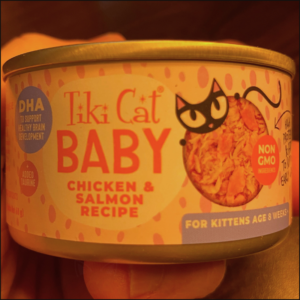
If price is no barrier, then Tiki Cat Baby is one of your best options.
Their chicken and salmon recipes are rich in omega 3 which helps with learning development.
The food comes in a shredded human food appearance which smells and looks great.
The other cool thing is you can get mousse and shreds, to help with solid food transition.
Only real issue is the price.
| Key Features | Information |
|---|---|
| Lifestage | All |
| Texture | Mousse and shreds |
| Protein* | 63% |
| Carbs | 2% |
| Kcal/kg | 1,175 |
| Cost/oz. (market ave) | $0.70 ($0.54) |
Premium human-grade quality
Filler free for easy digestion
Smells and looks great
Very pricey
No chicken free options
Best Budget Wet Kitten Food
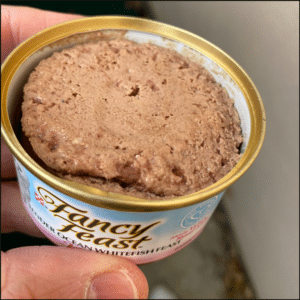
Fancy Feast kitten stands up above other budget foods with it’s low carb content which helps make digestion easier.
It’s packed with meat rich protein specially formulated for growing bodies. The food is affordable and generally enjoyed by most kittens.
The variety of flavors including salmon, whitefish, and chicken will help stop boredom.
Downsides include the smell and appearance.
| Key Features | Information |
|---|---|
| Lifestage | Growth |
| Texture | Pate |
| Protein* | 55% |
| Carbs | 5% |
| Kcal/kg | 1,064 |
| Cost/oz. (market ave) | $0.29 ($0.54) |
Variety of flavors to stop boredom
Easy-to-chew pate texture
Grain-free for easy digestion
Not the best smelling
Looks mediocre
Best Wet Kitten Food for Picky Eaters
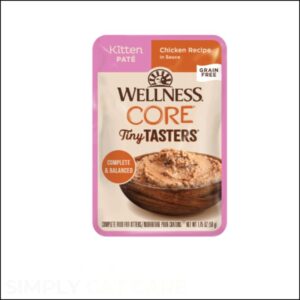
I’ve used Wellness Core Tiny Tasters many times and all cats enjoyed it in my experience.
It’s meat rich and grain-free to keep the gassy farts away. You know what I’m talking about..
The pouches are easy to open and pour it without the hassle of opening a tin every time. Lastly, it’s beefier in calories than most to support healthy weight gain.
It’s another pricier option though.
| Key Features | Information |
|---|---|
| Lifestage | Growth |
| Texture | Pate |
| Protein* | 63% |
| Carbs | 2% |
| Kcal/kg | 1,400 |
| Cost/oz. (market ave) | $0.73 ($0.54) |
Easy-to-chew pate texture
High calorie for weight gain
Easy serve pouch
Pricey
Thai made
What to Look for in Wet Foods for Your Kitten?
Kittens reach adulthood at 12 months.
They are raised on their mother’s milk until 4-8 weeks, so you get a short window for development.
Here’s what you need to look for:
Choose High Protein Kitten Food
Foods that are high in protein are foods your kitten will love and will help them build strong healthy bodies.
Aim for at least 35% protein on a dry basis.
This is a sign of a high-quality kitten food. Cats are obligate carnivores and protein is the most important nutrient for growth.
How do you know if you’re getting enough?
Check the guaranteed analysis and use a cat food nutrition calculator to find the dry matter basis protein.
Animal protein foods are the highest quality, whilst grain protein is less optimal. Make sure the wet food contains meat as a first ingredient.
Quick notes:
- A high protein diet is best for a growing kittens body.
- Aim for at least 35% protein (check with a nutrition calculator).
- As a general rule, look for meat as a first ingredient as this is high in protein.
Choose a Complete Meal for Kittens
Look for the statement:
(name of the food) formulated to meet the nutritional levels established by the AAFCO Cat Food Nutrient Profiles for (all life stages/growth) (or words to this effect)
This statement means the kitten food includes all the nutrients needed to support a kitten’s growth and development. This is usually on the back or side.
The reason you want to check for this statement is to know the food is made and formulated for kittens. If food meets the nutritional needs of kittens it makes sure they grow and develop normally.
AAFCO provides nutrition guidelines. They aren’t laws, but help manufactures make balanced kitten food.
Quick notes:
- Check the statement of nutritional adequacy on the label.
- Make sure meets needs for growth or all life stages (appropriate for kittens).
- This ensures your kitten is getting the nutrients they need for development.
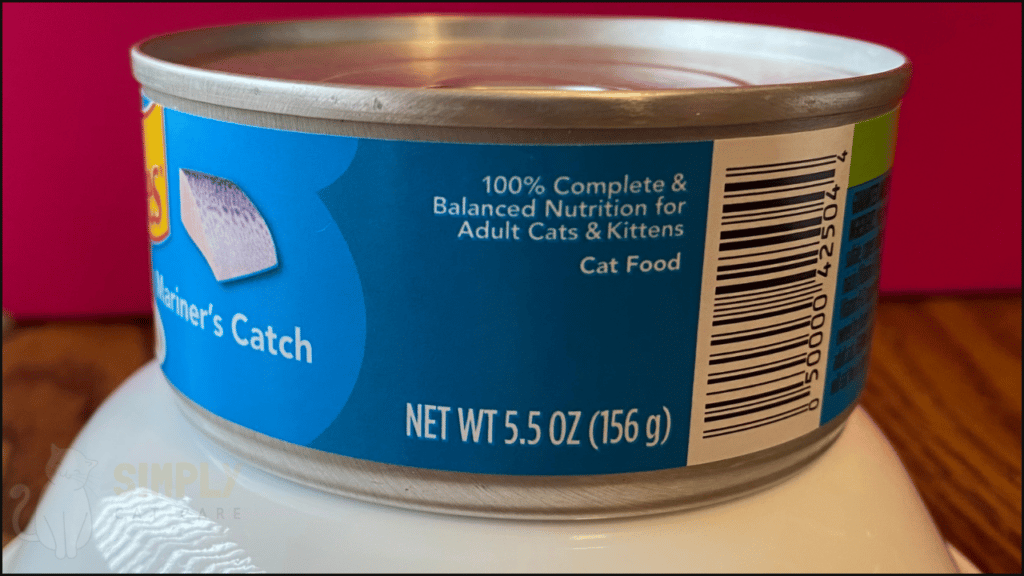
Look for Added Calcium
Calcium is a nutrient that kitten require for strong bones & teeth.
Kittens must get calcium, as deficiency leads to:
- Movement problems
- Depression
- Confusion
This is why the food you choose is important that it is formulated for growth (which will have the calcium kittens need).
More specifically you need 0.8-1.6% calcium (dry matter). That can come from food (e.g. milk, ground bones) or supplemental form (e.g. calcium carbonate).
This is also why an ‘all meat’ diet is unhealthy for kittens. Meat does not contain much calcium, so isn’t enough for a healthy kitten.
Quick notes:
- Calcium is essential for growing strong bones and teeth.
- A calcium deficiency affects movement and growth.
- Avoid all meat diets as they don’t have enough calcium.
Offer Variety
Mix it up.
Kittens get used to different flavors as they develop and prefer what they ate as kittens.
Packs of wet kitten food with a variety of flavors are a great way to change flavors. Or you can opt for different canned kitten foods and rotate from time to time.
The more kitten food variety, the more flavors they’ll learn to love. It also stops ‘flavor boredom’ (neophilia) from eating the same food every day.
Quick notes:
- Kittens get used to flavors as they grow.
- This shapes their food preferences as adult cats.
- More flavors as kittens = more to choose from as adults!
Ingredient Quality
Kittens are carnivores.
Meat, fish, and poultry are high in the 11 essential amino acids cats need (what makes protein). This makes them high-quality food sources for young kittens.
You want to make sure the food is packed with of get enough of all these amino acids
Experts suggest 19% animal protein (dry matter) minimum to get enough. Most wet kitten food contains enough meat so you’re good here, but I’d be weary if meat isn’t a first ingredient.
Whole food ingredients is a marketing term that means anything. It’s always best to choose foods that contain meat, as this what is quality for kitten nutrition.
Quick notes:
- Kittens are carnivores.
- Choose kitten food formulas with at least 19% animal protein.
- Animal protein is high in essential amino acids (needed for growth).
Frequently Asked Questions
Conclusion
Kittens need a high calorie and protein diet for growth, reaching adulthood at 12 months.
Look for the statement of nutritional adequacy meeting the needs for growth or all life stages. This ensures you get a complete meal.
Good wet kitten food is high in animal protein and calcium. Fewer fillers like grains, gums, and carrageenan is preferable.
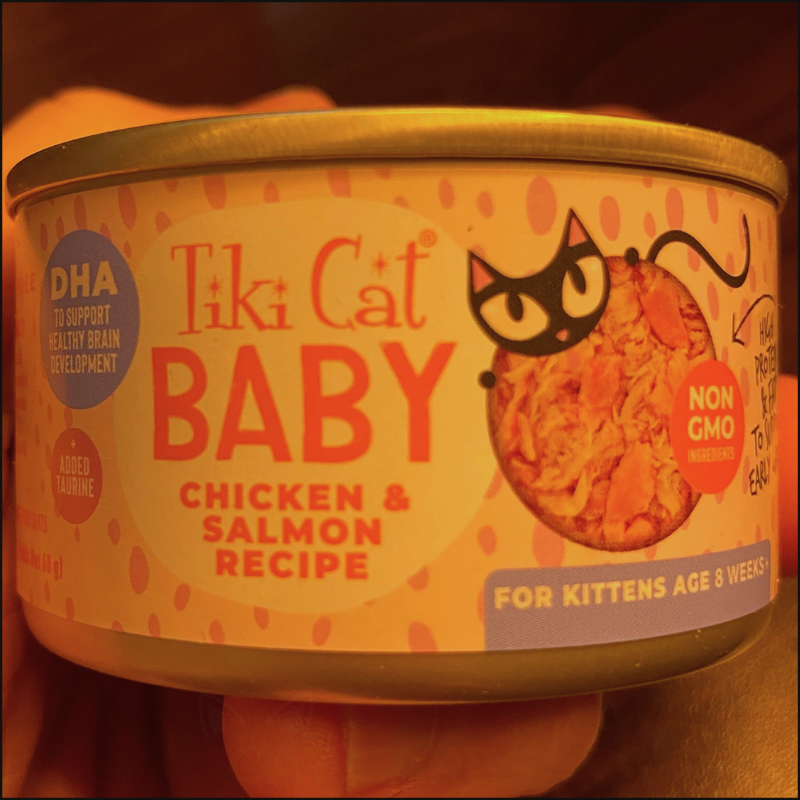
Human grade quality
No carbs for easy digestion
DHA for growing minds
Complete nutrition for all ages
Grain and soy free
Resources:
- Dry Matter Basis Calculator
- How to Read a Cat Food Label
- How Much to Feed Your Cat?
- KMR Guidelines for Kittens
- AAFCO Nutrition Guidelines
Related:

